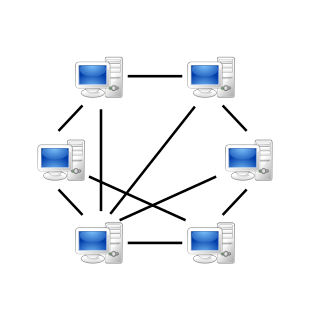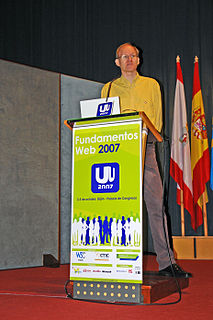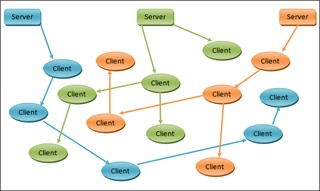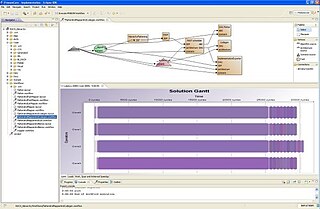Related Research Articles
The Internet protocol suite, commonly known as TCP/IP, is the set of communications protocols used in the Internet and similar computer networks. The current foundational protocols in the suite are the Transmission Control Protocol (TCP) and the Internet Protocol (IP).

Peer-to-peer (P2P) computing or networking is a distributed application architecture that partitions tasks or workloads between peers. Peers are equally privileged, equipotent participants in the application. They are said to form a peer-to-peer network of nodes.

Streaming media is multimedia that is delivered and consumed in a continuous manner from a source, with little or no intermediate storage in network elements. Streaming refers to the delivery method of content, rather than the content itself.

Video on demand (VOD) is a media distribution system that allows users to access videos without a traditional video playback device and the constraints of a typical static broadcasting schedule. In the 20th century, broadcasting in the form of over-the-air programming was the most common form of media distribution. As Internet and IPTV technologies continued to develop in the 1990s, consumers began to gravitate towards non-traditional modes of content consumption, which culminated in the arrival of VOD on televisions and personal computers.
Ultra-wideband is a radio technology that can use a very low energy level for short-range, high-bandwidth communications over a large portion of the radio spectrum. UWB has traditional applications in non-cooperative radar imaging. Most recent applications target sensor data collection, precision locating and tracking applications. UWB support started to appear in high-end smartphones c. 2019.

Télécom Paris is a French public institution for higher education and engineering research. Located in Palaiseau, it is also a member of the Institut Polytechnique de Paris and the Institut Mines-Télécom. In 2021 it was the sixth highest ranked French university in the World University Rankings, and the 7th best small university worldwide. In the QS Ranking, Télécom Paris is the 64th best university worldwide in Computer Science.
A pulse, in physiology, is the throbbing of arteries resulting from heartbeat.

Sophia Antipolis is a 2,400 hectare technology park in France, and as of 2021 home to 2,500 companies, valued today at more than 5.6 billion euros and employing more than 38,000 people counting more than 80 nationalities. The park is known to be Europe's first science and technology hub. The technology park is also a platform, cluster and creation-hub for start-ups.

Gijsbert (Bert) Bos is a computer scientist known for the development of Argo, a web browser he developed as test application for his style sheet proposal.

A content delivery network, or content distribution network (CDN), is a geographically distributed network of proxy servers and their data centers. The goal is to provide high availability and performance by distributing the service spatially relative to end users. CDNs came into existence in the late 1990s as a means for alleviating the performance bottlenecks of the Internet as the Internet was starting to become a mission-critical medium for people and enterprises. Since then, CDNs have grown to serve a large portion of the Internet content today, including web objects, downloadable objects, applications, live streaming media, on-demand streaming media, and social media sites.
Streaming television is the digital distribution of television content, such as TV shows, as streaming media delivered over the Internet. Streaming TV stands in contrast to dedicated terrestrial television delivered by over-the-air aerial systems, cable television, and/or satellite television systems. The use of streaming online video and streaming television is concentrated on streaming video on demand platforms such as Netflix, Tubi, Crackle, Hulu, Amazon Prime Video, HBO Max, Vudu, Showmax, Peacock, Disney+, Apple TV+, BET+, and Paramount+.
Peercasting is a method of multicasting streams, usually audio and/or video, to the Internet via peer-to-peer technology. It can be used for commercial, independent, and amateur multicasts. Unlike traditional IP Multicast, peercasting can facilitate on-demand content delivery.
CoolStreaming is a P2PTV technology that enables users to share television content with each other over the Internet. The technology behind CoolStreaming is similar to that of BitTorrent. The viewers upload content at the same time the programs are downloaded and viewed. CoolStreaming creates a local stream on localhost and that stream is then read by Windows Media Player, RealPlayer or other media players. The original coolstreaming code is developed with Python 2.3 on Windows.

P2PTV refers to peer-to-peer (P2P) software applications designed to redistribute video streams in real time on a P2P network; the distributed video streams are typically TV channels from all over the world but may also come from other sources. The draw to these applications is significant because they have the potential to make any TV channel globally available by any individual feeding the stream into the network where each peer joining to watch the video is a relay to other peer viewers, allowing a scalable distribution among a large audience with no incremental cost for the source.

PulseAudio is a network-capable sound server program distributed via the freedesktop.org project. It runs mainly on Linux, various BSD distributions such as FreeBSD and OpenBSD, macOS, as well as Illumos distributions and the Solaris operating system.
ns is a name for a series of discrete event network simulators, specifically ns-1, ns-2, and ns-3. All are discrete-event computer network simulators, primarily used in research and teaching.
Barry Martin Schuler is an American Internet entrepreneur and former chairman and CEO of America Online Inc. He is best known for leading the AOL team that simplified the online service provider's user interface, making it possible for millions of consumers to gain easy access to the Internet.
The Secure Real-Time Media Flow Protocol (RTMFP) is a protocol suite developed by Adobe Systems for encrypted, efficient multimedia delivery through both client-server and peer-to-peer models over the Internet. The protocol was originally proprietary, but was later opened up and is now published as RFC 7016.
Pulse-code modulation (PCM) is a method used to digitally represent sampled analog signals. It is the standard form of digital audio in computers, compact discs, digital telephony and other digital audio applications. In a PCM stream, the amplitude of the analog signal is sampled regularly at uniform intervals, and each sample is quantized to the nearest value within a range of digital steps.

PREESM is an open-source rapid prototyping and code generation tool. It is primarily employed to simulate signal processing applications and generate code for multi-core Digital Signal Processors. PREESM is developed at the Institute of Electronics and Telecommunications-Rennes (IETR) in collaboration with Texas Instruments France in Nice.
References
- ↑ Fabio Pianese PULSE - An Adaptive Practical Live Streaming System PhD Thesis, Université de Nice - Sophia Antipolis, December 2007
- ↑ Diego Perino The Pulse System - A new p2p prototype for live streaming MSc Thesis, Institut Eurecom, Sophia-Antipolis, September 2006
- ↑ PULSE page on the NAPA-WINE consortium website Archived 2009-05-16 at the Wayback Machine
- ↑ P2PMyLive web site Archived 2013-01-22 at archive.today